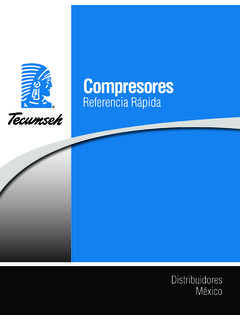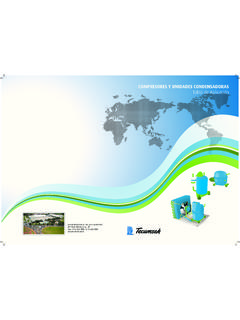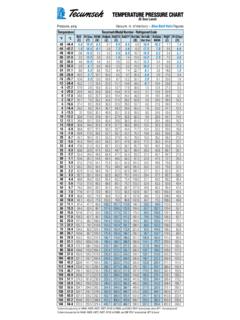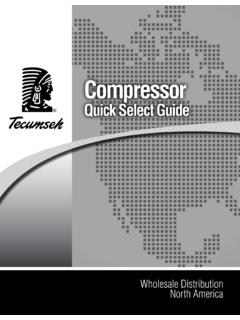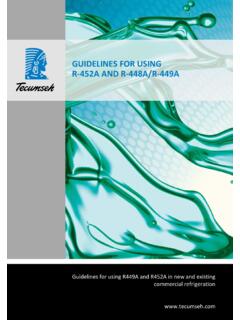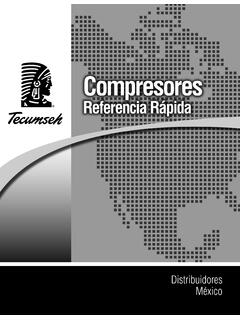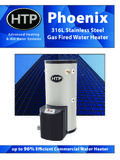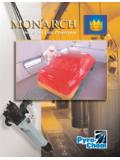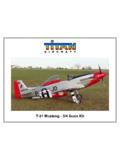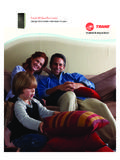Transcription of Hermetic Compressor - TECUMSEH
1 Hermetic CompressorService HandbookWholesale DistributionNorth AmericaHermetic CompressorService HandbookAnn Arbor, MI 48108 REV 3/11 Handbook Purpose and DescriptionTecumseh Products Company has prepared this Service Handbook to assist service personnel in safely installing and servicing refrigeration and air conditioning equipment. The information in this Service Handbook is generally limited to the Compressor and to items and conditions affecting the installation, operation, and servicing of the Compressor . It is not designed to be a textbook or to replace the training required for professional service technicians. Also, it is not intended to replace other information available from the refrigeration and air conditioning system Service Safety Precautions 1 Introduction 2 Trained Personnel Only 2 Terminal Venting and Electrocution 2 Refrigerants and Other Chemicals 4 Compressor Removal 4 System Flushing, Purging.
2 And Pressure Testing for Leaks 4 System Charging 5 Prevention of Water-Utilizing System Explosions 6 Start Capacitor Overheating 7 System Evacuation 7 Follow the Labels 8 Model and Application 9 Compressor Model Number Codes 10 Condensing Unit Model Number Codes 11 Serial Label Information 12 Basic Application Information for Hermetic Compressors 13 Compressor Motor and Component 15 Single-phase Compressor Motor Types 16 PSC Motor Starting 17 Hermetic Compressor Thermal Protectors 19 Compressor Motor Starting Relays 21 Selecting Capacitors 24 Identification of Terminal Pins 26 Fuse and Circuit Breaker Sizing 26 Servicing 29 Introduction to Servicing 31 Think 31 Before Servicing 31 Servicing or Troubleshooting Water-utilizing Systems: Preventing Explosions 32 Troubleshooting Chart 34 Installation and Replacement 73 Compressor Tube Connections 74 Refrigerant Line Sizes 76 Service Valves 82 Processing the System 82 System Cleanup and Compressor Replacement After Compressor Failure 83 Replacing Compressors in Water-Utilizing Systems.
3 Preventing Explosions 87 Operation 89 Control of Liquid Migration to the Compressor During Shutdown 90 Crankcase Heaters 93 Starting a System with Liquid Refrigerant in the Compressor 94 Control of Liquid Refrigerant Floodback to the Compressor During Operation 95 Accumulator Selection 98 Internal Pressure Relief Valves 99 Appendix 101 The Basic Refrigeration Cycle 102 Example of a TECUMSEH Hermetic Compressor 104 Reciprocating Compressor 105 Capillary Tube Sizing 106 Approved Hermetic Compressor Oils 108 Notes 110 Table of ContentsChapter 1 General Service Safety Precautions2 SERVICE HANDBOOKI ntroductionTecumseh Products Company has prepared this handbook to assist service personnel in safely working with refrigeration and air conditioning equipment that uses TECUMSEH Products Company Hermetic compressors. It is not designed to replace the training required for professional service personnel.
4 It is also not intended to replace other information available from refrigeration and air conditioning equipment Personnel OnlyServicing, repairing, and troubleshooting refrigeration and air conditioning systems should be done only by those with the necessary knowledge, training, and Venting and ElectrocutionImproperly servicing, repairing, or troubleshooting a Compressor can lead to electrocution or fire due to terminal venting with ignition. Follow the precautions below to avoid serious injury or death from electrocution or terminal venting with Hazard from Terminal Venting with IgnitionOil and refrigerant can spray out of the Compressor if one of the terminal pins is ejected from the Hermetic terminal. This terminal venting can occur as a result of a ground fault (also known as a short circuit to ground) in the Compressor . The oil and refrigerant spray from terminal venting can be ignited by electricity and produce flames that can lead to serious burns or death.
5 See figures 1-1 through 1-3 for Venting and Electrocution PrecautionsTo reduce the risk of electrocution or serious burns or death from terminal venting with ignition: Be alert for sounds of arcing (sizzling, sputtering or popping) inside the Compressor . IMMEDIATELY GET AWAY if you hear these sounds. Disconnect ALL electrical power before removing the protective terminal cover. Make sure that all power legs are open. (NOTE: The system may have more than one power supply.) Never energize the system unless: 1) the protective terminal cover is securely fastened, and 2) the Compressor is properly connected to ground. Figures 1-4 through 1-6 illustrate the different means of fastening protective terminal covers. Never reset a breaker or replace a fuse without first checking for a ground fault (a short circuit to ground). An open fuse or tripped circuit breaker is a strong indication of a ground fault (also know as a short circuit to ground).
6 Use only a megohmmeter ( megger ) or a Hi-Potential Ground tester (Hi-Pot) to check for a ground fault. A conventional ohmmeter will not reliably detect a ground fault under certain circumstances. See the Service Handbook for more informa-tion on checking for a ground fault. Also, always follow the megger or Hi-Pot manufacturer s procedures and safety rules. If a ground fault does exist, keep the power off. WARNING! To avoid electric shock, electro-cution, and terminal venting with ignition, do not energize a Compressor that has a ground !W A R N I N GNever service, repair, or troubleshoot unless you are qualified to perform these functions. Improper servicing can lead to serious injury or death from fire, electrical shock, or Mark and red tag the Compressor to indicate that there is a ground fault. Do not recon -nect the power leads.
7 Tape and insulate each power lead separately. Disconnect power before servicing. Always disconnect power before servicing unless it is required for a specific troubleshooting technique. In these situations, use extreme caution to avoid electric 1-1: Compressor with (1) protective cover and (2) bale strap removed to show (3) Hermetic 1-2: Close up view of Hermetic terminal show-ing individual terminal pins with power leads 1-3: Close up view of Hermetic teminal after it has 1-4: Compressor with (1) protective cover held in place by (2) metal bale 1-5: Compressor with (1) protective cover held in place by (2) 1-6: Compressor with (1) snap in protective HANDBOOKR efrigerants and Other ChemicalsContact with refrigerant, mixtures of refrigerant and oil, or other chemicals can cause a variety of injuries including burns and frostbite.
8 For example, if refrigerant contacts skin or eyes, it can cause severe frostbite. Also, in the event of a Compressor motor failure, some refrigerant and oil mixtures can be acidic and can cause chemical avoid injury, wear appropriate protective eye wear, gloves, and clothing when servicing an air conditioning or refrigeration system. Refer to your refrigerant supplier for more refrigerant or mixtures of refrigerant and oil come in contact with skin or eyes, flush the exposed area with water and get medical attention RemovalFailure to properly remove the Compressor can result in serious injury or death from electrocution, fire, or sudden release of refrigerant and these precautions when removing a Compressor from a system: Disconnect ALL electrical power. Disconnect all electrical power supplies to the system making sure that all power legs are open. (NOTE: the system may have more than one power supply.)
9 Be sure refrigerant is recovered before removing Compressor . Attempting to remove the Compressor before removing all refrigerant from the system can cause a sudden release of refrigerant and oil. Among other things, this can: cause a variety of injuries including burns and frostbite. cause a fire if a torch is used to disconnect tubing. expose the service person to toxic gas. To avoid serious injury or death, be sure to remove and recover all refrigerant before removing the Compressor . Use a tubing cutter, not a torch. Use a tubing cutter to remove the Compressor . A torch can cause even trace amounts of refrigerant to decompose and release toxic fumes. In addition, using a torch to remove the Compressor can cause a fire. If you ignore this recommendation and use a torch, be prepared to extinguish a Flushing, Purging, and Pressure Testing for LeaksFailure to properly purge or pressure test a system for leaks can result in serious injury or death from explosion, fire, or contact with acid-saturated refrigerant or oil these precautions when purging or pressure testing a system for leaks: TECUMSEH discourages the use of flushing products and recommends the use of suction line filter-drier and proper oil changes.
10 If the use of a flushing agent is absolutely necessary, follow the flushing agent manufacturer's instructions. To purge a system, use only dry nitrogen. When pressure testing for leaks, use only regulated dry nitrogen or dry nitrogen plus trace amounts of the serial label refrigerant. When purging or pressure testing any refrigeration or air conditioning system for leaks, never use air, oxygen or acetylene. Oxygen can explode on contact with oil. Acetylene can decompose and explode when exposed to pressure greater than approximately 15 psig. Combining an oxidizing gas such as oxygen or air, with an HCFC or HFC refrigerant under pressure can result in a fire or Use a pressure regulating valve and pressure gauges. Commercial cylinders of nitrogen contain pressures in excess of 2000 psig at 70 F. At pressures much lower than 2000 psig, compressors can explode and cause serious injury or death.
